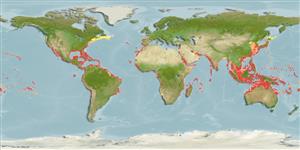Classificação / Names
Common names from other countries
Referência principal
Tamanho / Peso / Idade
Max length : 70.0 cm TL macho/indeterminado; (Ref. 48635)
Ambiente
; marinhas associadas(os) a recifes; intervalo de profundidade 0 - 170 m (Ref. 9283), usually 2 - 10 m (Ref. 40849)
Clima / Intervalo
Subtropical, preferred 27°C (Ref. 107945); 47°N - 24°S, 180°W - 180°E
Distribuição
Circumtropical. Indo-Pacific: East Africa (Ref. 3287) to Rapa, north to southern Japan and the Hawaiian Islands, south to New Caledonia. Eastern Pacific: Mexico to Peru, including the Galapagos Islands (Ref. 5530). Western Atlantic: Nova Scotia, Canada and Bermuda through the Gulf of Mexico and the Caribbean to to São Paulo (Ref. 47377), Brazil. Eastern Atlantic: Cape Verde to southern Angola (Ref. 7097).
Países | Áreas FAO | Ecossistemas | Ocorrências | Introduções
Descrição breve
Espinhos dorsais (total): 9; Raios dorsais moles (total): 24-27; Espinhos anais 3; Raios anais moles: 21 - 23.
Categoria na Lista Vermelha da IUCN (Ref. 115185)
Ameaça para o homem
Reports of ciguatera poisoning (Ref. 30911)
Utilização humana
Pescarias: altamente comercial; peixe desportivo: sim; isco: usually
Ferramentas
Relatórios especiais
Descarregue XML
Fontes da internet
Estimates of some properties based on models
Phylogenetic diversity index
PD50 = 0.7500 many relatives (e.g. carps) 0.5 - 2.0 few relatives (e.g. lungfishes)
Nível Trófico
3.8 ±0.2 se; Based on diet studies.
Resiliência
Elevada, tempo mínimo de duplicação da população menor que 15 meses (K=0.6-0.9)
Vulnerabilidade
Moderate vulnerability (39 of 100)
Categoria de preço
